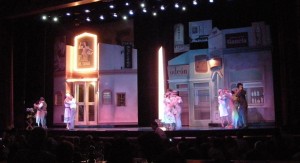According to Shakespeare, in his comedy of manners and disguises As You Like It, all the world’s a stage. Everyone’s just a temporary player, with a certain role and time to enter and exit this existence.
Yet, even when someone’s not taking center stage, they, or their memory, can still play an important role. In life, as in a dramatic production, a lot can happen behind the scenes.
This month, our contributors pull back the curtain and peer at how nature and society function underneath the surface.
Returning poet Dave Douglas illustrates his speaker’s journey through wild country on a Greyhound bus. He reflects on his Christian faith’s ideals of perseverance, courage and sacrifice while passing through rough terrain.
Writer G.K. Brannen also explores the psychological and emotional implications of a physical journey, that of organ transplantation. He looks at what it means to live through another person’s death, with part of his or her body inside oneself. Also drawing upon Biblical and creation imagery, he considers this topic through poetry and prose.
Bea Garth incorporates rich and specific detail about the natural world into her work, making the riverbeds, stones, seaweed and milfoil as lush and sensual as her romantic couples. Elements of the scene that would likely be in the background of a photograph or painting come to the forefront in Garth’s work, where all of life holds value and beauty.
Science journalist Cristina Deptula reviews a talk on the early development of the universe by San Francisco State University professor Dr. Mary Barsony, at the Chabot Space and Science Center (Oakland, CA). Dr. Barsony outlines the expanding and cooling of matter into light and heavier elements after the Big Bang, and then personalizes the grandiose topic, tracing the origin of the body parts of a hypothetical, average person. At a basic level, the abstract universe has to do with us, and each of us, as a living being, is part of it.
Human societies, and social groups, also can involve underlying feelings and interactions that build up and lead to the obvious, big-picture events we notice. Scott Archer Jones examines the thoughts and relationships among ordinary people in a small town bar. Carol Smallwood highlights the power of fragrances and photographs to bring back memories in her vignette about a woman’s home visit from a new provider of Avon cosmetics.
Ayokunle Adeleye explains the reasons behind student discontent at his Nigerian medical school, which faces financial and administrative problems. Long-term structural injustice and misery can fuel outward strikes and conflicts, as he illustrates.
Tom Reiss’ biography The Black Count, as reviewed by Bruce Roberts, tells the story of the real African-American figure who inspired the legend of the Count of Monte Cristo. The book illuminates a heritage of slavery and racial discrimination through the changing fortunes of one man.
Linda Allen’s poetry turns inward, encouraging readers to ask themselves difficult questions about who they are, how they think and treat others, and who they are becoming. Perhaps by changing inner attitudes, we can affect interpersonal behavior, and thus improve society.
Eric Franklin’s new self-development book Peanut Butter Principles, as reviewed by Elizabeth Hughes in her monthly Book Periscope column, advocates a similar attitude of self-reflection, along with discipline, patience, and hard work. Hughes also offers high praise for Deborah Hawkins’ Dance for a Dead Princess, for its suspense and writing quality.
Other contributors look to art and mythology to fuel their musings. Christopher Bernard speculates about the thoughts of the Minotaur, a half-human, half-bull creature feeding on sacrificed young people caught within his labyrinth. Bernard’s work often centers on the search for love and identity despite difficult, alienating circumstances, and this piece touches upon those themes in a unique way.
Returning poet Neil Ellman conveys the Surrealistic artistic ethos through his poetry, playing with humor and individuality in pieces echoing the spirit of paintings by Dali and Basquiat.
Journalist Martin Rushmere writes about an actual play, Sam Shepard’s Fool for Love, produced and presented by Marin County’s Alter Theater and San Francisco’s ACT Costume Shop Theater. This tale focuses on deep issues and secrets, festering over the years and ruining the relationships in a family.
Finally, writer, film director and photographer Faracy Grouse shows us the majesty of the sunset, rainbows, and waves: where many elements have come together to create a striking scene.
She, and the month’s other artists and writers, invite you to take your seat and enjoy the show, appreciating the onstage performance while remembering the complex world behind the scenes.

